Building Law - An Overview of the Building and Construction Industry Security of Payment Act (NSW)
VerifiedAdded on 2022/10/15
|9
|2430
|436
AI Summary
This article provides an overview of the Building and Construction Industry Security of Payment Act (NSW) and its role in providing security and protection to sub-contractors and other individuals in the contractual chain who fail to obtain correct payments for their work in the construction and structures industry.
Contribute Materials
Your contribution can guide someone’s learning journey. Share your
documents today.
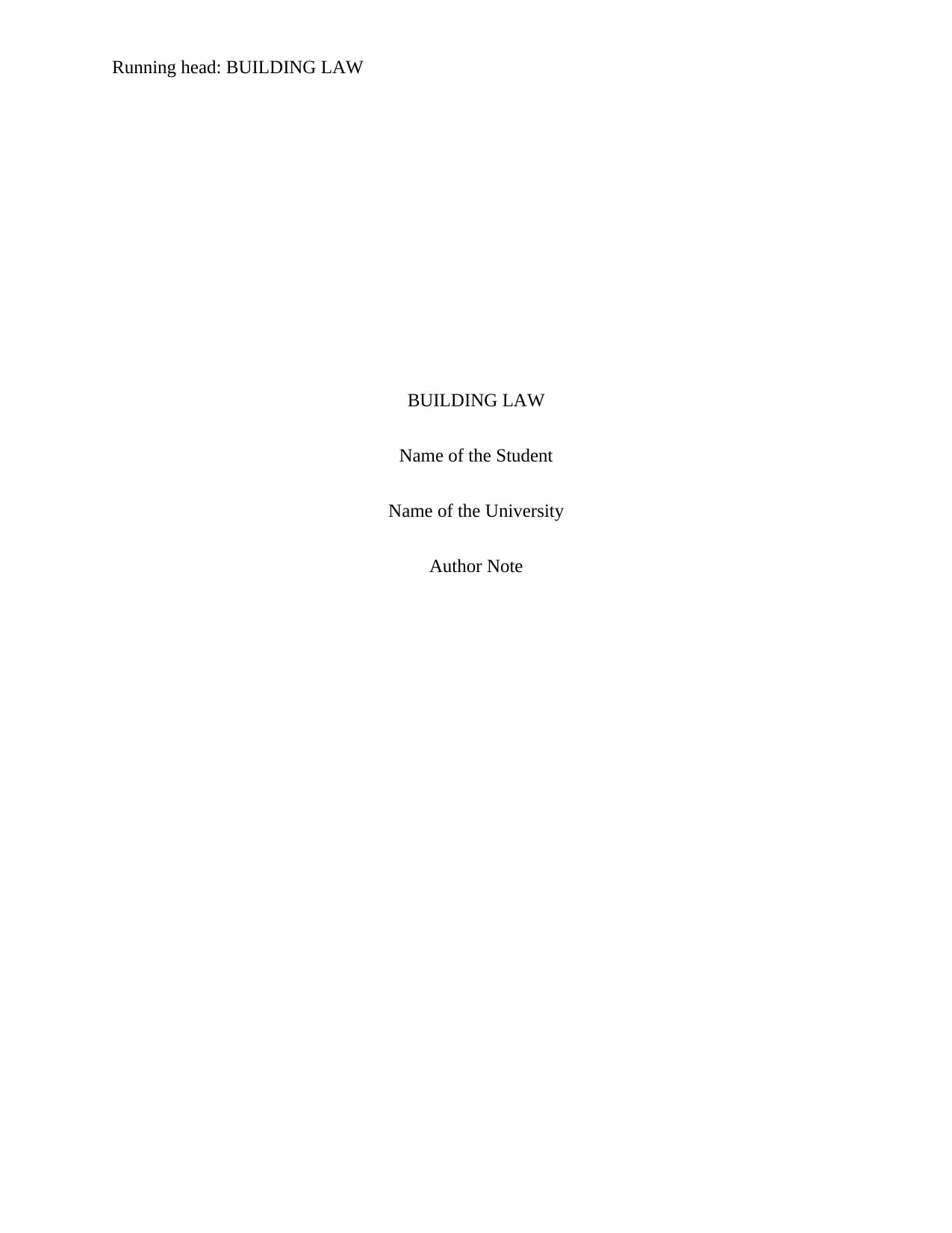
Running head: BUILDING LAW
BUILDING LAW
Name of the Student
Name of the University
Author Note
BUILDING LAW
Name of the Student
Name of the University
Author Note
Secure Best Marks with AI Grader
Need help grading? Try our AI Grader for instant feedback on your assignments.
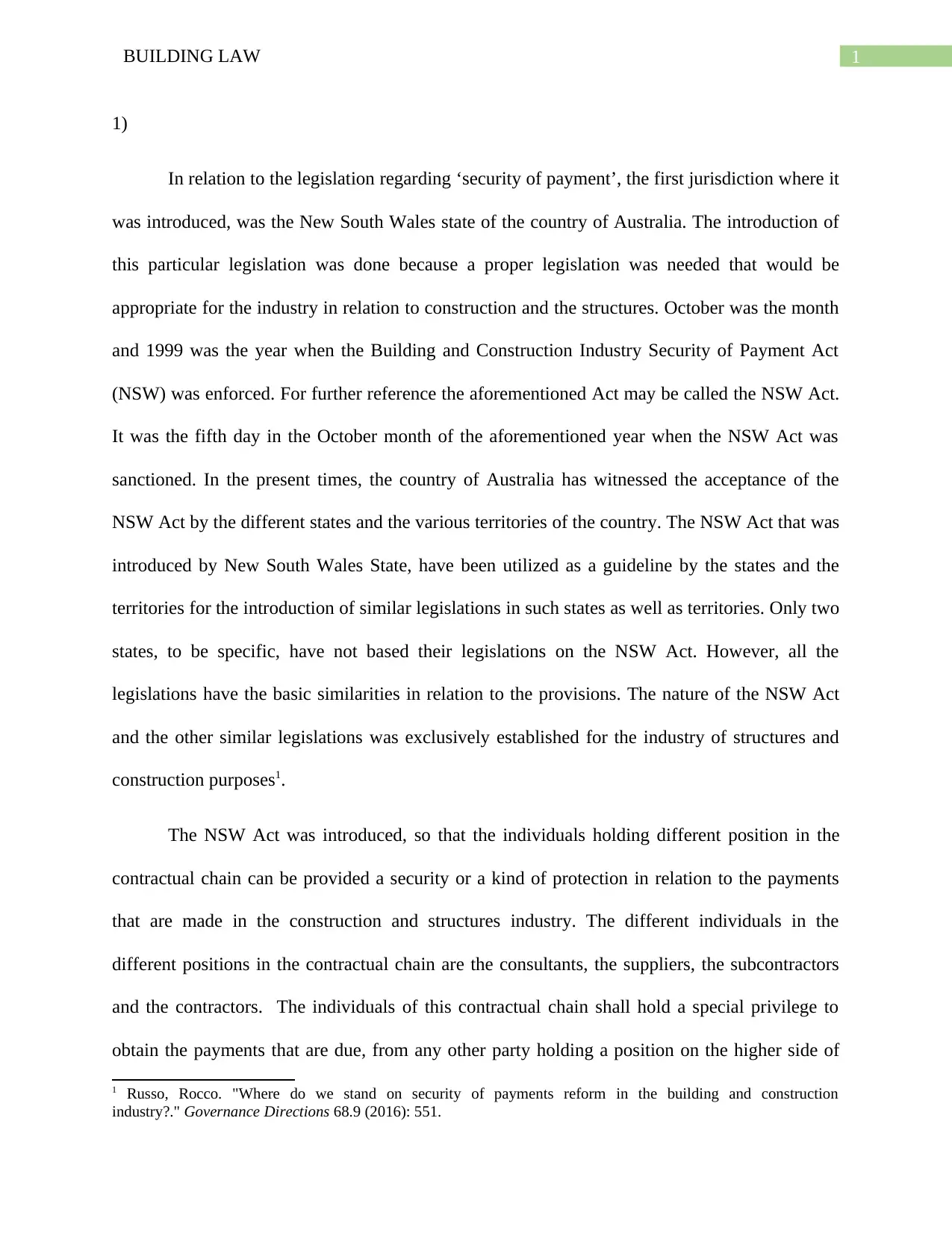
1BUILDING LAW
1)
In relation to the legislation regarding ‘security of payment’, the first jurisdiction where it
was introduced, was the New South Wales state of the country of Australia. The introduction of
this particular legislation was done because a proper legislation was needed that would be
appropriate for the industry in relation to construction and the structures. October was the month
and 1999 was the year when the Building and Construction Industry Security of Payment Act
(NSW) was enforced. For further reference the aforementioned Act may be called the NSW Act.
It was the fifth day in the October month of the aforementioned year when the NSW Act was
sanctioned. In the present times, the country of Australia has witnessed the acceptance of the
NSW Act by the different states and the various territories of the country. The NSW Act that was
introduced by New South Wales State, have been utilized as a guideline by the states and the
territories for the introduction of similar legislations in such states as well as territories. Only two
states, to be specific, have not based their legislations on the NSW Act. However, all the
legislations have the basic similarities in relation to the provisions. The nature of the NSW Act
and the other similar legislations was exclusively established for the industry of structures and
construction purposes1.
The NSW Act was introduced, so that the individuals holding different position in the
contractual chain can be provided a security or a kind of protection in relation to the payments
that are made in the construction and structures industry. The different individuals in the
different positions in the contractual chain are the consultants, the suppliers, the subcontractors
and the contractors. The individuals of this contractual chain shall hold a special privilege to
obtain the payments that are due, from any other party holding a position on the higher side of
1 Russo, Rocco. "Where do we stand on security of payments reform in the building and construction
industry?." Governance Directions 68.9 (2016): 551.
1)
In relation to the legislation regarding ‘security of payment’, the first jurisdiction where it
was introduced, was the New South Wales state of the country of Australia. The introduction of
this particular legislation was done because a proper legislation was needed that would be
appropriate for the industry in relation to construction and the structures. October was the month
and 1999 was the year when the Building and Construction Industry Security of Payment Act
(NSW) was enforced. For further reference the aforementioned Act may be called the NSW Act.
It was the fifth day in the October month of the aforementioned year when the NSW Act was
sanctioned. In the present times, the country of Australia has witnessed the acceptance of the
NSW Act by the different states and the various territories of the country. The NSW Act that was
introduced by New South Wales State, have been utilized as a guideline by the states and the
territories for the introduction of similar legislations in such states as well as territories. Only two
states, to be specific, have not based their legislations on the NSW Act. However, all the
legislations have the basic similarities in relation to the provisions. The nature of the NSW Act
and the other similar legislations was exclusively established for the industry of structures and
construction purposes1.
The NSW Act was introduced, so that the individuals holding different position in the
contractual chain can be provided a security or a kind of protection in relation to the payments
that are made in the construction and structures industry. The different individuals in the
different positions in the contractual chain are the consultants, the suppliers, the subcontractors
and the contractors. The individuals of this contractual chain shall hold a special privilege to
obtain the payments that are due, from any other party holding a position on the higher side of
1 Russo, Rocco. "Where do we stand on security of payments reform in the building and construction
industry?." Governance Directions 68.9 (2016): 551.
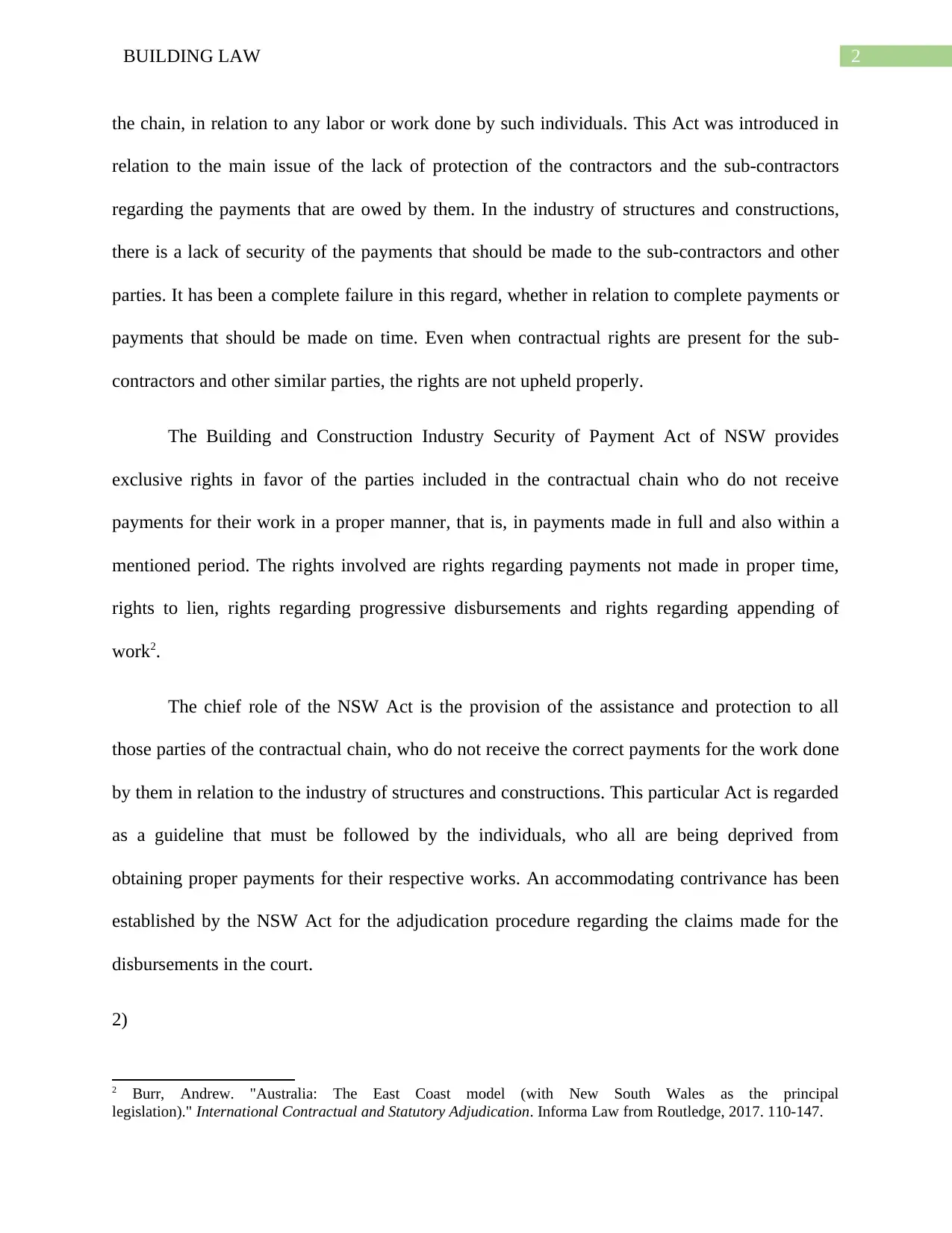
2BUILDING LAW
the chain, in relation to any labor or work done by such individuals. This Act was introduced in
relation to the main issue of the lack of protection of the contractors and the sub-contractors
regarding the payments that are owed by them. In the industry of structures and constructions,
there is a lack of security of the payments that should be made to the sub-contractors and other
parties. It has been a complete failure in this regard, whether in relation to complete payments or
payments that should be made on time. Even when contractual rights are present for the sub-
contractors and other similar parties, the rights are not upheld properly.
The Building and Construction Industry Security of Payment Act of NSW provides
exclusive rights in favor of the parties included in the contractual chain who do not receive
payments for their work in a proper manner, that is, in payments made in full and also within a
mentioned period. The rights involved are rights regarding payments not made in proper time,
rights to lien, rights regarding progressive disbursements and rights regarding appending of
work2.
The chief role of the NSW Act is the provision of the assistance and protection to all
those parties of the contractual chain, who do not receive the correct payments for the work done
by them in relation to the industry of structures and constructions. This particular Act is regarded
as a guideline that must be followed by the individuals, who all are being deprived from
obtaining proper payments for their respective works. An accommodating contrivance has been
established by the NSW Act for the adjudication procedure regarding the claims made for the
disbursements in the court.
2)
2 Burr, Andrew. "Australia: The East Coast model (with New South Wales as the principal
legislation)." International Contractual and Statutory Adjudication. Informa Law from Routledge, 2017. 110-147.
the chain, in relation to any labor or work done by such individuals. This Act was introduced in
relation to the main issue of the lack of protection of the contractors and the sub-contractors
regarding the payments that are owed by them. In the industry of structures and constructions,
there is a lack of security of the payments that should be made to the sub-contractors and other
parties. It has been a complete failure in this regard, whether in relation to complete payments or
payments that should be made on time. Even when contractual rights are present for the sub-
contractors and other similar parties, the rights are not upheld properly.
The Building and Construction Industry Security of Payment Act of NSW provides
exclusive rights in favor of the parties included in the contractual chain who do not receive
payments for their work in a proper manner, that is, in payments made in full and also within a
mentioned period. The rights involved are rights regarding payments not made in proper time,
rights to lien, rights regarding progressive disbursements and rights regarding appending of
work2.
The chief role of the NSW Act is the provision of the assistance and protection to all
those parties of the contractual chain, who do not receive the correct payments for the work done
by them in relation to the industry of structures and constructions. This particular Act is regarded
as a guideline that must be followed by the individuals, who all are being deprived from
obtaining proper payments for their respective works. An accommodating contrivance has been
established by the NSW Act for the adjudication procedure regarding the claims made for the
disbursements in the court.
2)
2 Burr, Andrew. "Australia: The East Coast model (with New South Wales as the principal
legislation)." International Contractual and Statutory Adjudication. Informa Law from Routledge, 2017. 110-147.
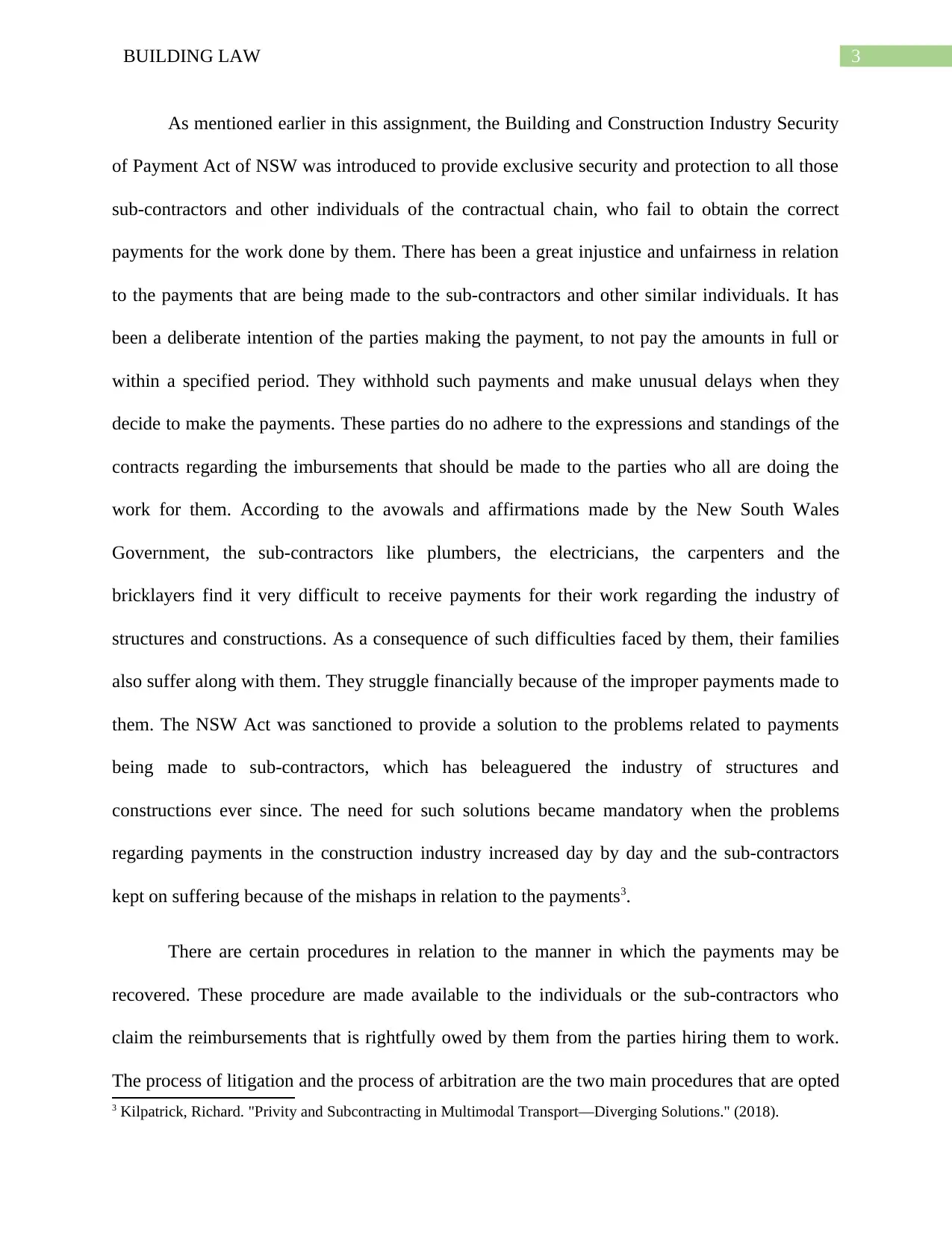
3BUILDING LAW
As mentioned earlier in this assignment, the Building and Construction Industry Security
of Payment Act of NSW was introduced to provide exclusive security and protection to all those
sub-contractors and other individuals of the contractual chain, who fail to obtain the correct
payments for the work done by them. There has been a great injustice and unfairness in relation
to the payments that are being made to the sub-contractors and other similar individuals. It has
been a deliberate intention of the parties making the payment, to not pay the amounts in full or
within a specified period. They withhold such payments and make unusual delays when they
decide to make the payments. These parties do no adhere to the expressions and standings of the
contracts regarding the imbursements that should be made to the parties who all are doing the
work for them. According to the avowals and affirmations made by the New South Wales
Government, the sub-contractors like plumbers, the electricians, the carpenters and the
bricklayers find it very difficult to receive payments for their work regarding the industry of
structures and constructions. As a consequence of such difficulties faced by them, their families
also suffer along with them. They struggle financially because of the improper payments made to
them. The NSW Act was sanctioned to provide a solution to the problems related to payments
being made to sub-contractors, which has beleaguered the industry of structures and
constructions ever since. The need for such solutions became mandatory when the problems
regarding payments in the construction industry increased day by day and the sub-contractors
kept on suffering because of the mishaps in relation to the payments3.
There are certain procedures in relation to the manner in which the payments may be
recovered. These procedure are made available to the individuals or the sub-contractors who
claim the reimbursements that is rightfully owed by them from the parties hiring them to work.
The process of litigation and the process of arbitration are the two main procedures that are opted
3 Kilpatrick, Richard. "Privity and Subcontracting in Multimodal Transport—Diverging Solutions." (2018).
As mentioned earlier in this assignment, the Building and Construction Industry Security
of Payment Act of NSW was introduced to provide exclusive security and protection to all those
sub-contractors and other individuals of the contractual chain, who fail to obtain the correct
payments for the work done by them. There has been a great injustice and unfairness in relation
to the payments that are being made to the sub-contractors and other similar individuals. It has
been a deliberate intention of the parties making the payment, to not pay the amounts in full or
within a specified period. They withhold such payments and make unusual delays when they
decide to make the payments. These parties do no adhere to the expressions and standings of the
contracts regarding the imbursements that should be made to the parties who all are doing the
work for them. According to the avowals and affirmations made by the New South Wales
Government, the sub-contractors like plumbers, the electricians, the carpenters and the
bricklayers find it very difficult to receive payments for their work regarding the industry of
structures and constructions. As a consequence of such difficulties faced by them, their families
also suffer along with them. They struggle financially because of the improper payments made to
them. The NSW Act was sanctioned to provide a solution to the problems related to payments
being made to sub-contractors, which has beleaguered the industry of structures and
constructions ever since. The need for such solutions became mandatory when the problems
regarding payments in the construction industry increased day by day and the sub-contractors
kept on suffering because of the mishaps in relation to the payments3.
There are certain procedures in relation to the manner in which the payments may be
recovered. These procedure are made available to the individuals or the sub-contractors who
claim the reimbursements that is rightfully owed by them from the parties hiring them to work.
The process of litigation and the process of arbitration are the two main procedures that are opted
3 Kilpatrick, Richard. "Privity and Subcontracting in Multimodal Transport—Diverging Solutions." (2018).
Secure Best Marks with AI Grader
Need help grading? Try our AI Grader for instant feedback on your assignments.
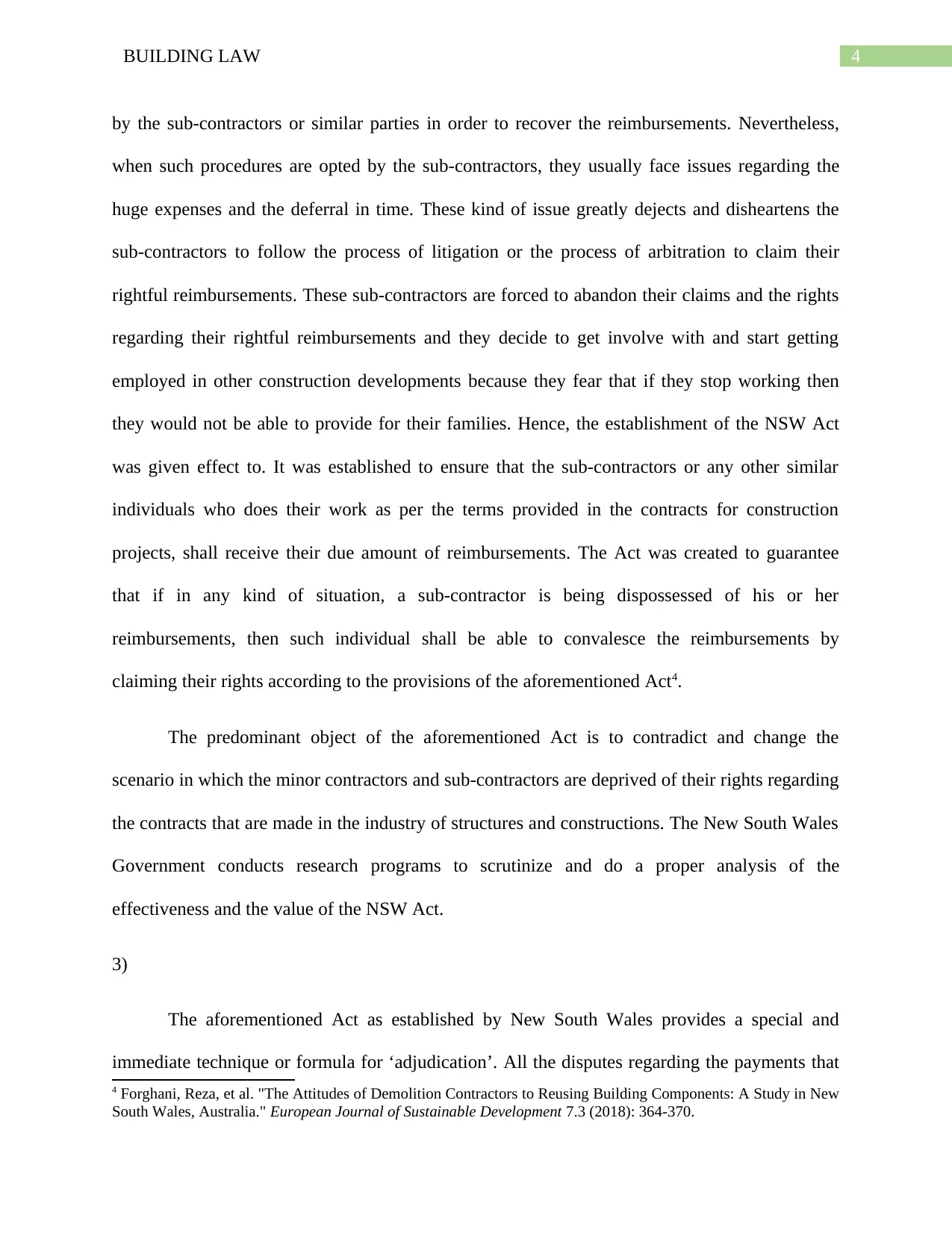
4BUILDING LAW
by the sub-contractors or similar parties in order to recover the reimbursements. Nevertheless,
when such procedures are opted by the sub-contractors, they usually face issues regarding the
huge expenses and the deferral in time. These kind of issue greatly dejects and disheartens the
sub-contractors to follow the process of litigation or the process of arbitration to claim their
rightful reimbursements. These sub-contractors are forced to abandon their claims and the rights
regarding their rightful reimbursements and they decide to get involve with and start getting
employed in other construction developments because they fear that if they stop working then
they would not be able to provide for their families. Hence, the establishment of the NSW Act
was given effect to. It was established to ensure that the sub-contractors or any other similar
individuals who does their work as per the terms provided in the contracts for construction
projects, shall receive their due amount of reimbursements. The Act was created to guarantee
that if in any kind of situation, a sub-contractor is being dispossessed of his or her
reimbursements, then such individual shall be able to convalesce the reimbursements by
claiming their rights according to the provisions of the aforementioned Act4.
The predominant object of the aforementioned Act is to contradict and change the
scenario in which the minor contractors and sub-contractors are deprived of their rights regarding
the contracts that are made in the industry of structures and constructions. The New South Wales
Government conducts research programs to scrutinize and do a proper analysis of the
effectiveness and the value of the NSW Act.
3)
The aforementioned Act as established by New South Wales provides a special and
immediate technique or formula for ‘adjudication’. All the disputes regarding the payments that
4 Forghani, Reza, et al. "The Attitudes of Demolition Contractors to Reusing Building Components: A Study in New
South Wales, Australia." European Journal of Sustainable Development 7.3 (2018): 364-370.
by the sub-contractors or similar parties in order to recover the reimbursements. Nevertheless,
when such procedures are opted by the sub-contractors, they usually face issues regarding the
huge expenses and the deferral in time. These kind of issue greatly dejects and disheartens the
sub-contractors to follow the process of litigation or the process of arbitration to claim their
rightful reimbursements. These sub-contractors are forced to abandon their claims and the rights
regarding their rightful reimbursements and they decide to get involve with and start getting
employed in other construction developments because they fear that if they stop working then
they would not be able to provide for their families. Hence, the establishment of the NSW Act
was given effect to. It was established to ensure that the sub-contractors or any other similar
individuals who does their work as per the terms provided in the contracts for construction
projects, shall receive their due amount of reimbursements. The Act was created to guarantee
that if in any kind of situation, a sub-contractor is being dispossessed of his or her
reimbursements, then such individual shall be able to convalesce the reimbursements by
claiming their rights according to the provisions of the aforementioned Act4.
The predominant object of the aforementioned Act is to contradict and change the
scenario in which the minor contractors and sub-contractors are deprived of their rights regarding
the contracts that are made in the industry of structures and constructions. The New South Wales
Government conducts research programs to scrutinize and do a proper analysis of the
effectiveness and the value of the NSW Act.
3)
The aforementioned Act as established by New South Wales provides a special and
immediate technique or formula for ‘adjudication’. All the disputes regarding the payments that
4 Forghani, Reza, et al. "The Attitudes of Demolition Contractors to Reusing Building Components: A Study in New
South Wales, Australia." European Journal of Sustainable Development 7.3 (2018): 364-370.
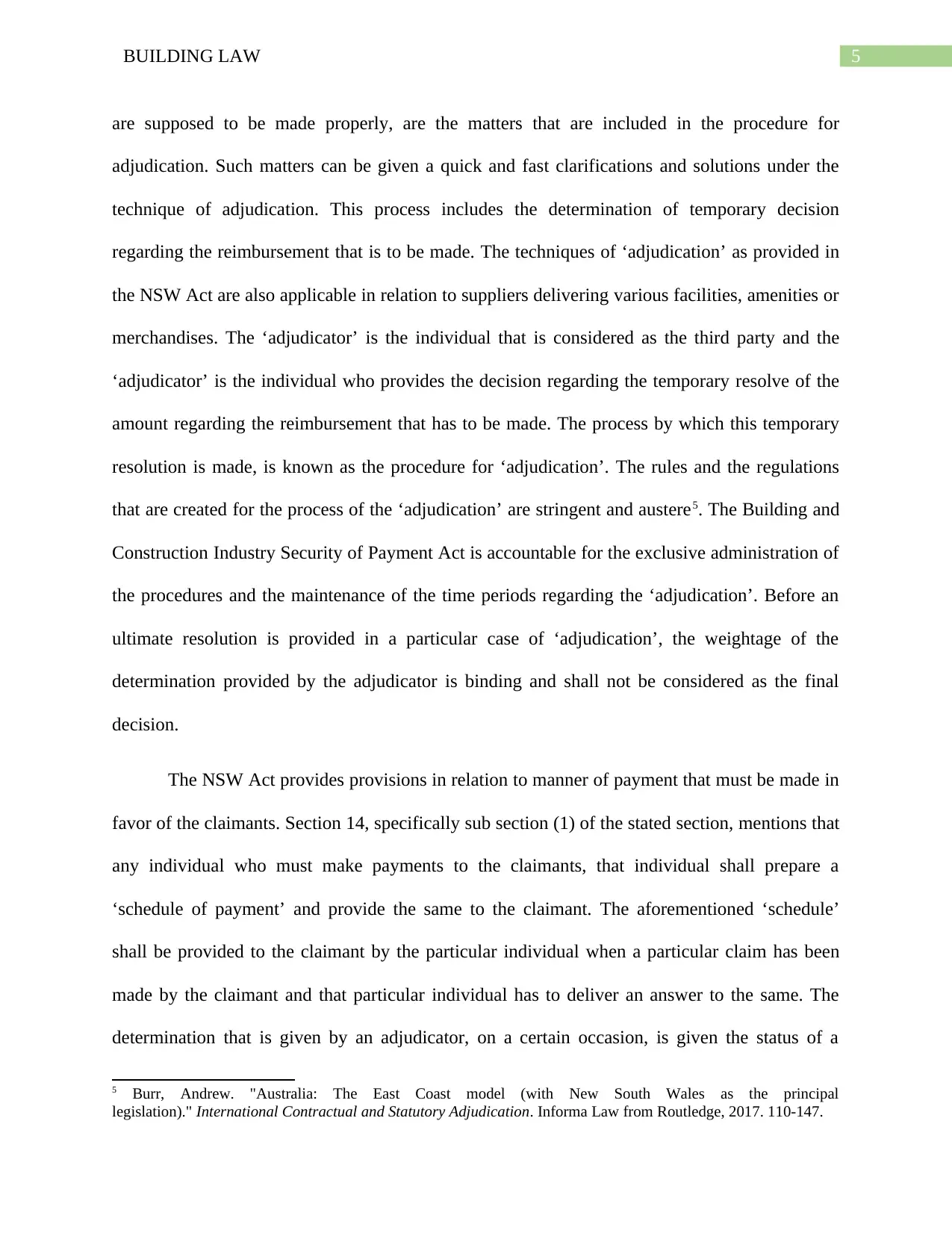
5BUILDING LAW
are supposed to be made properly, are the matters that are included in the procedure for
adjudication. Such matters can be given a quick and fast clarifications and solutions under the
technique of adjudication. This process includes the determination of temporary decision
regarding the reimbursement that is to be made. The techniques of ‘adjudication’ as provided in
the NSW Act are also applicable in relation to suppliers delivering various facilities, amenities or
merchandises. The ‘adjudicator’ is the individual that is considered as the third party and the
‘adjudicator’ is the individual who provides the decision regarding the temporary resolve of the
amount regarding the reimbursement that has to be made. The process by which this temporary
resolution is made, is known as the procedure for ‘adjudication’. The rules and the regulations
that are created for the process of the ‘adjudication’ are stringent and austere5. The Building and
Construction Industry Security of Payment Act is accountable for the exclusive administration of
the procedures and the maintenance of the time periods regarding the ‘adjudication’. Before an
ultimate resolution is provided in a particular case of ‘adjudication’, the weightage of the
determination provided by the adjudicator is binding and shall not be considered as the final
decision.
The NSW Act provides provisions in relation to manner of payment that must be made in
favor of the claimants. Section 14, specifically sub section (1) of the stated section, mentions that
any individual who must make payments to the claimants, that individual shall prepare a
‘schedule of payment’ and provide the same to the claimant. The aforementioned ‘schedule’
shall be provided to the claimant by the particular individual when a particular claim has been
made by the claimant and that particular individual has to deliver an answer to the same. The
determination that is given by an adjudicator, on a certain occasion, is given the status of a
5 Burr, Andrew. "Australia: The East Coast model (with New South Wales as the principal
legislation)." International Contractual and Statutory Adjudication. Informa Law from Routledge, 2017. 110-147.
are supposed to be made properly, are the matters that are included in the procedure for
adjudication. Such matters can be given a quick and fast clarifications and solutions under the
technique of adjudication. This process includes the determination of temporary decision
regarding the reimbursement that is to be made. The techniques of ‘adjudication’ as provided in
the NSW Act are also applicable in relation to suppliers delivering various facilities, amenities or
merchandises. The ‘adjudicator’ is the individual that is considered as the third party and the
‘adjudicator’ is the individual who provides the decision regarding the temporary resolve of the
amount regarding the reimbursement that has to be made. The process by which this temporary
resolution is made, is known as the procedure for ‘adjudication’. The rules and the regulations
that are created for the process of the ‘adjudication’ are stringent and austere5. The Building and
Construction Industry Security of Payment Act is accountable for the exclusive administration of
the procedures and the maintenance of the time periods regarding the ‘adjudication’. Before an
ultimate resolution is provided in a particular case of ‘adjudication’, the weightage of the
determination provided by the adjudicator is binding and shall not be considered as the final
decision.
The NSW Act provides provisions in relation to manner of payment that must be made in
favor of the claimants. Section 14, specifically sub section (1) of the stated section, mentions that
any individual who must make payments to the claimants, that individual shall prepare a
‘schedule of payment’ and provide the same to the claimant. The aforementioned ‘schedule’
shall be provided to the claimant by the particular individual when a particular claim has been
made by the claimant and that particular individual has to deliver an answer to the same. The
determination that is given by an adjudicator, on a certain occasion, is given the status of a
5 Burr, Andrew. "Australia: The East Coast model (with New South Wales as the principal
legislation)." International Contractual and Statutory Adjudication. Informa Law from Routledge, 2017. 110-147.
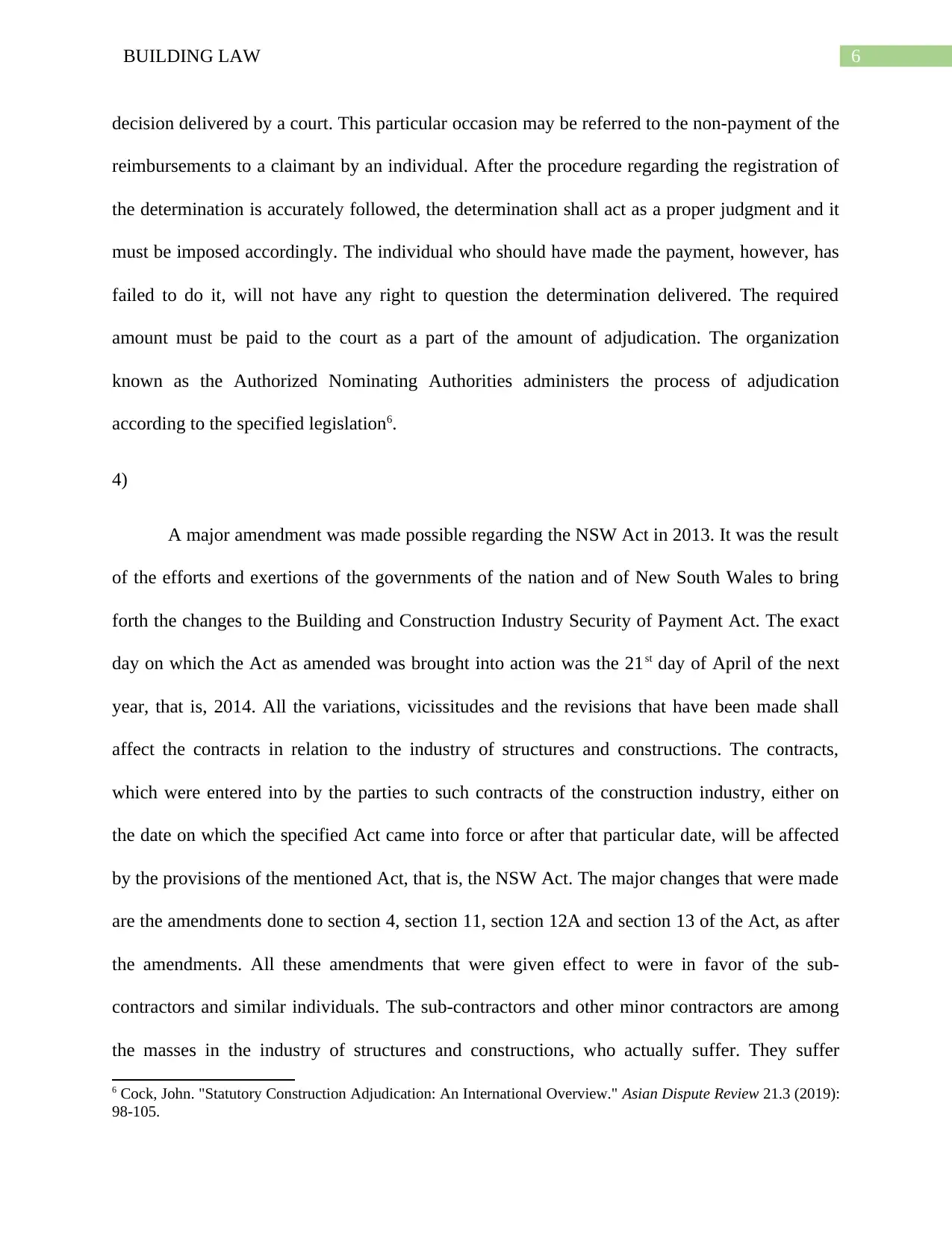
6BUILDING LAW
decision delivered by a court. This particular occasion may be referred to the non-payment of the
reimbursements to a claimant by an individual. After the procedure regarding the registration of
the determination is accurately followed, the determination shall act as a proper judgment and it
must be imposed accordingly. The individual who should have made the payment, however, has
failed to do it, will not have any right to question the determination delivered. The required
amount must be paid to the court as a part of the amount of adjudication. The organization
known as the Authorized Nominating Authorities administers the process of adjudication
according to the specified legislation6.
4)
A major amendment was made possible regarding the NSW Act in 2013. It was the result
of the efforts and exertions of the governments of the nation and of New South Wales to bring
forth the changes to the Building and Construction Industry Security of Payment Act. The exact
day on which the Act as amended was brought into action was the 21st day of April of the next
year, that is, 2014. All the variations, vicissitudes and the revisions that have been made shall
affect the contracts in relation to the industry of structures and constructions. The contracts,
which were entered into by the parties to such contracts of the construction industry, either on
the date on which the specified Act came into force or after that particular date, will be affected
by the provisions of the mentioned Act, that is, the NSW Act. The major changes that were made
are the amendments done to section 4, section 11, section 12A and section 13 of the Act, as after
the amendments. All these amendments that were given effect to were in favor of the sub-
contractors and similar individuals. The sub-contractors and other minor contractors are among
the masses in the industry of structures and constructions, who actually suffer. They suffer
6 Cock, John. "Statutory Construction Adjudication: An International Overview." Asian Dispute Review 21.3 (2019):
98-105.
decision delivered by a court. This particular occasion may be referred to the non-payment of the
reimbursements to a claimant by an individual. After the procedure regarding the registration of
the determination is accurately followed, the determination shall act as a proper judgment and it
must be imposed accordingly. The individual who should have made the payment, however, has
failed to do it, will not have any right to question the determination delivered. The required
amount must be paid to the court as a part of the amount of adjudication. The organization
known as the Authorized Nominating Authorities administers the process of adjudication
according to the specified legislation6.
4)
A major amendment was made possible regarding the NSW Act in 2013. It was the result
of the efforts and exertions of the governments of the nation and of New South Wales to bring
forth the changes to the Building and Construction Industry Security of Payment Act. The exact
day on which the Act as amended was brought into action was the 21st day of April of the next
year, that is, 2014. All the variations, vicissitudes and the revisions that have been made shall
affect the contracts in relation to the industry of structures and constructions. The contracts,
which were entered into by the parties to such contracts of the construction industry, either on
the date on which the specified Act came into force or after that particular date, will be affected
by the provisions of the mentioned Act, that is, the NSW Act. The major changes that were made
are the amendments done to section 4, section 11, section 12A and section 13 of the Act, as after
the amendments. All these amendments that were given effect to were in favor of the sub-
contractors and similar individuals. The sub-contractors and other minor contractors are among
the masses in the industry of structures and constructions, who actually suffer. They suffer
6 Cock, John. "Statutory Construction Adjudication: An International Overview." Asian Dispute Review 21.3 (2019):
98-105.
Paraphrase This Document
Need a fresh take? Get an instant paraphrase of this document with our AI Paraphraser
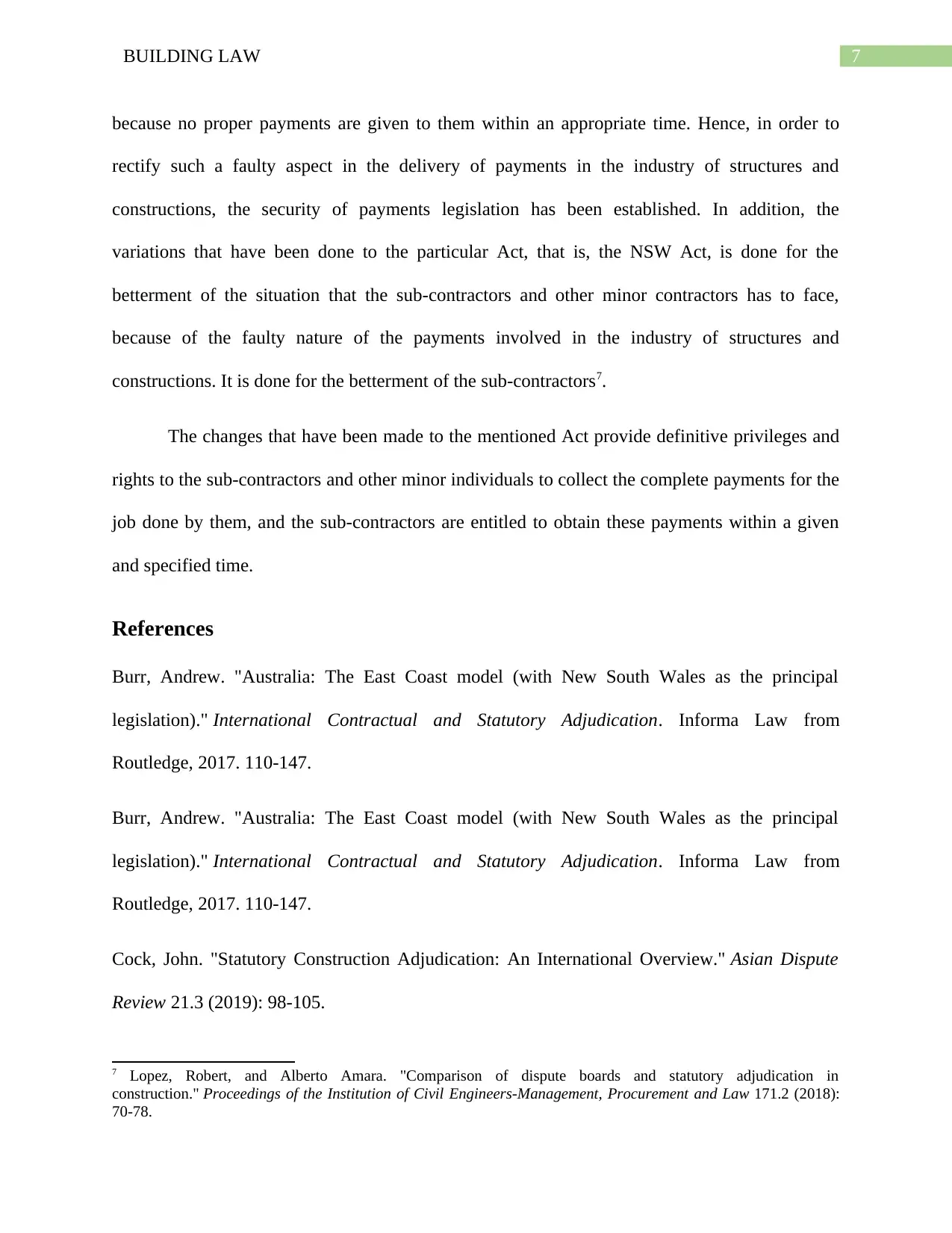
7BUILDING LAW
because no proper payments are given to them within an appropriate time. Hence, in order to
rectify such a faulty aspect in the delivery of payments in the industry of structures and
constructions, the security of payments legislation has been established. In addition, the
variations that have been done to the particular Act, that is, the NSW Act, is done for the
betterment of the situation that the sub-contractors and other minor contractors has to face,
because of the faulty nature of the payments involved in the industry of structures and
constructions. It is done for the betterment of the sub-contractors7.
The changes that have been made to the mentioned Act provide definitive privileges and
rights to the sub-contractors and other minor individuals to collect the complete payments for the
job done by them, and the sub-contractors are entitled to obtain these payments within a given
and specified time.
References
Burr, Andrew. "Australia: The East Coast model (with New South Wales as the principal
legislation)." International Contractual and Statutory Adjudication. Informa Law from
Routledge, 2017. 110-147.
Burr, Andrew. "Australia: The East Coast model (with New South Wales as the principal
legislation)." International Contractual and Statutory Adjudication. Informa Law from
Routledge, 2017. 110-147.
Cock, John. "Statutory Construction Adjudication: An International Overview." Asian Dispute
Review 21.3 (2019): 98-105.
7 Lopez, Robert, and Alberto Amara. "Comparison of dispute boards and statutory adjudication in
construction." Proceedings of the Institution of Civil Engineers-Management, Procurement and Law 171.2 (2018):
70-78.
because no proper payments are given to them within an appropriate time. Hence, in order to
rectify such a faulty aspect in the delivery of payments in the industry of structures and
constructions, the security of payments legislation has been established. In addition, the
variations that have been done to the particular Act, that is, the NSW Act, is done for the
betterment of the situation that the sub-contractors and other minor contractors has to face,
because of the faulty nature of the payments involved in the industry of structures and
constructions. It is done for the betterment of the sub-contractors7.
The changes that have been made to the mentioned Act provide definitive privileges and
rights to the sub-contractors and other minor individuals to collect the complete payments for the
job done by them, and the sub-contractors are entitled to obtain these payments within a given
and specified time.
References
Burr, Andrew. "Australia: The East Coast model (with New South Wales as the principal
legislation)." International Contractual and Statutory Adjudication. Informa Law from
Routledge, 2017. 110-147.
Burr, Andrew. "Australia: The East Coast model (with New South Wales as the principal
legislation)." International Contractual and Statutory Adjudication. Informa Law from
Routledge, 2017. 110-147.
Cock, John. "Statutory Construction Adjudication: An International Overview." Asian Dispute
Review 21.3 (2019): 98-105.
7 Lopez, Robert, and Alberto Amara. "Comparison of dispute boards and statutory adjudication in
construction." Proceedings of the Institution of Civil Engineers-Management, Procurement and Law 171.2 (2018):
70-78.
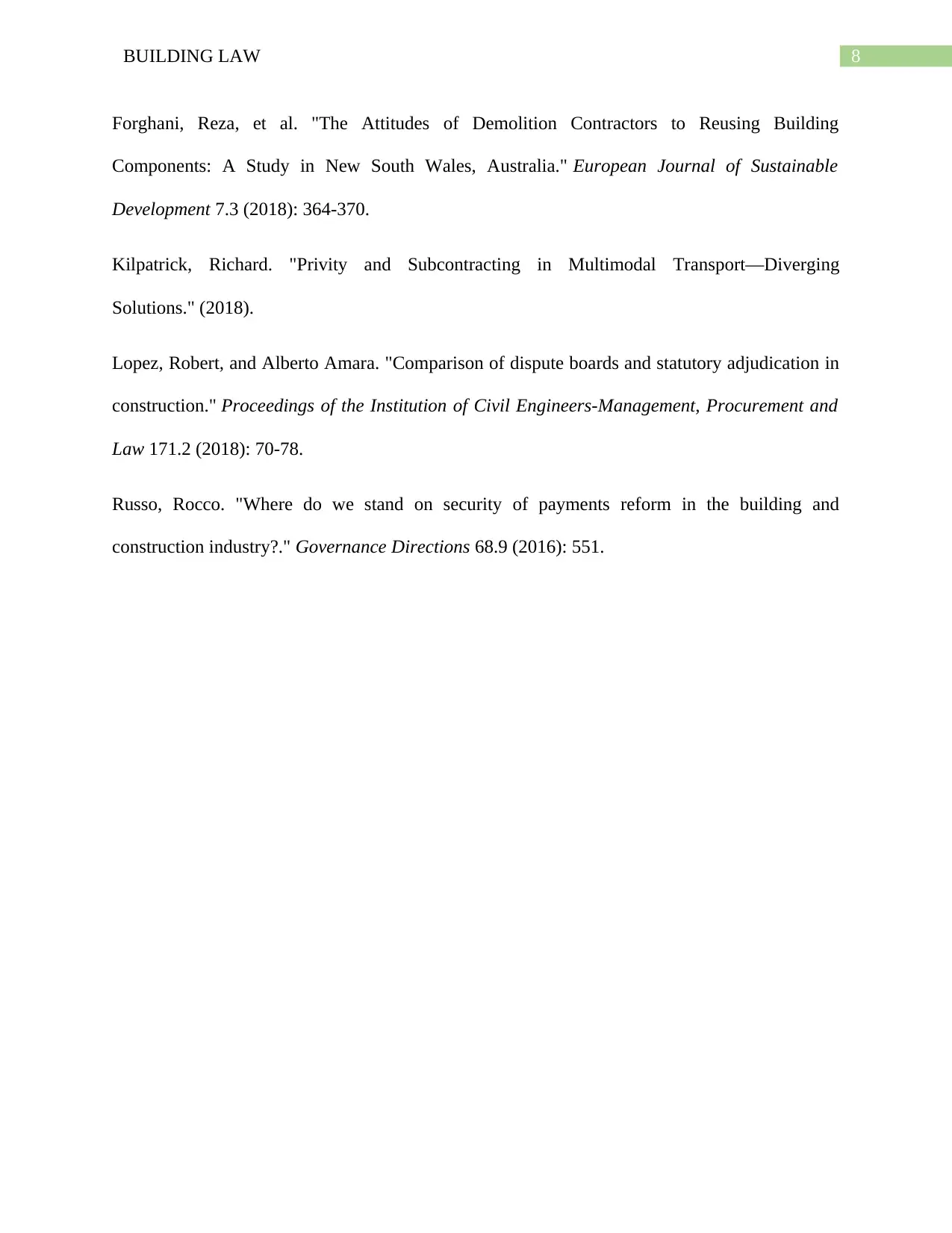
8BUILDING LAW
Forghani, Reza, et al. "The Attitudes of Demolition Contractors to Reusing Building
Components: A Study in New South Wales, Australia." European Journal of Sustainable
Development 7.3 (2018): 364-370.
Kilpatrick, Richard. "Privity and Subcontracting in Multimodal Transport—Diverging
Solutions." (2018).
Lopez, Robert, and Alberto Amara. "Comparison of dispute boards and statutory adjudication in
construction." Proceedings of the Institution of Civil Engineers-Management, Procurement and
Law 171.2 (2018): 70-78.
Russo, Rocco. "Where do we stand on security of payments reform in the building and
construction industry?." Governance Directions 68.9 (2016): 551.
Forghani, Reza, et al. "The Attitudes of Demolition Contractors to Reusing Building
Components: A Study in New South Wales, Australia." European Journal of Sustainable
Development 7.3 (2018): 364-370.
Kilpatrick, Richard. "Privity and Subcontracting in Multimodal Transport—Diverging
Solutions." (2018).
Lopez, Robert, and Alberto Amara. "Comparison of dispute boards and statutory adjudication in
construction." Proceedings of the Institution of Civil Engineers-Management, Procurement and
Law 171.2 (2018): 70-78.
Russo, Rocco. "Where do we stand on security of payments reform in the building and
construction industry?." Governance Directions 68.9 (2016): 551.
1 out of 9
Related Documents
Your All-in-One AI-Powered Toolkit for Academic Success.
+13062052269
info@desklib.com
Available 24*7 on WhatsApp / Email
![[object Object]](/_next/static/media/star-bottom.7253800d.svg)
Unlock your academic potential
© 2024 | Zucol Services PVT LTD | All rights reserved.





